Kurukshetra August 2024
Chapter 1- Future of Learning with Digital Education
- The advent of digital technologies has ushered in a new era of education, characterized by accessibility, personalization, and innovation.
- Digital education, encompassing the use of technology to enhance teaching and learning, has emerged as a powerful tool to democratize knowledge and bridge the digital divide
The integration of technology into education has witnessed exponential growth in recent years. Several factors have contributed to this phenomenon:
- Technological advancements: The proliferation of affordable smartphones, laptops, and high-speed internet connectivity has made digital devices accessible to a wider population.
- Global pandemic: The COVID-19 pandemic accelerated the adoption of online learning platforms as schools and universities were forced to shift to remote education.
- Government initiatives: Many countries have recognized the potential of digital education and have invested in infrastructure, digital content, and teacher training to promote its adoption.
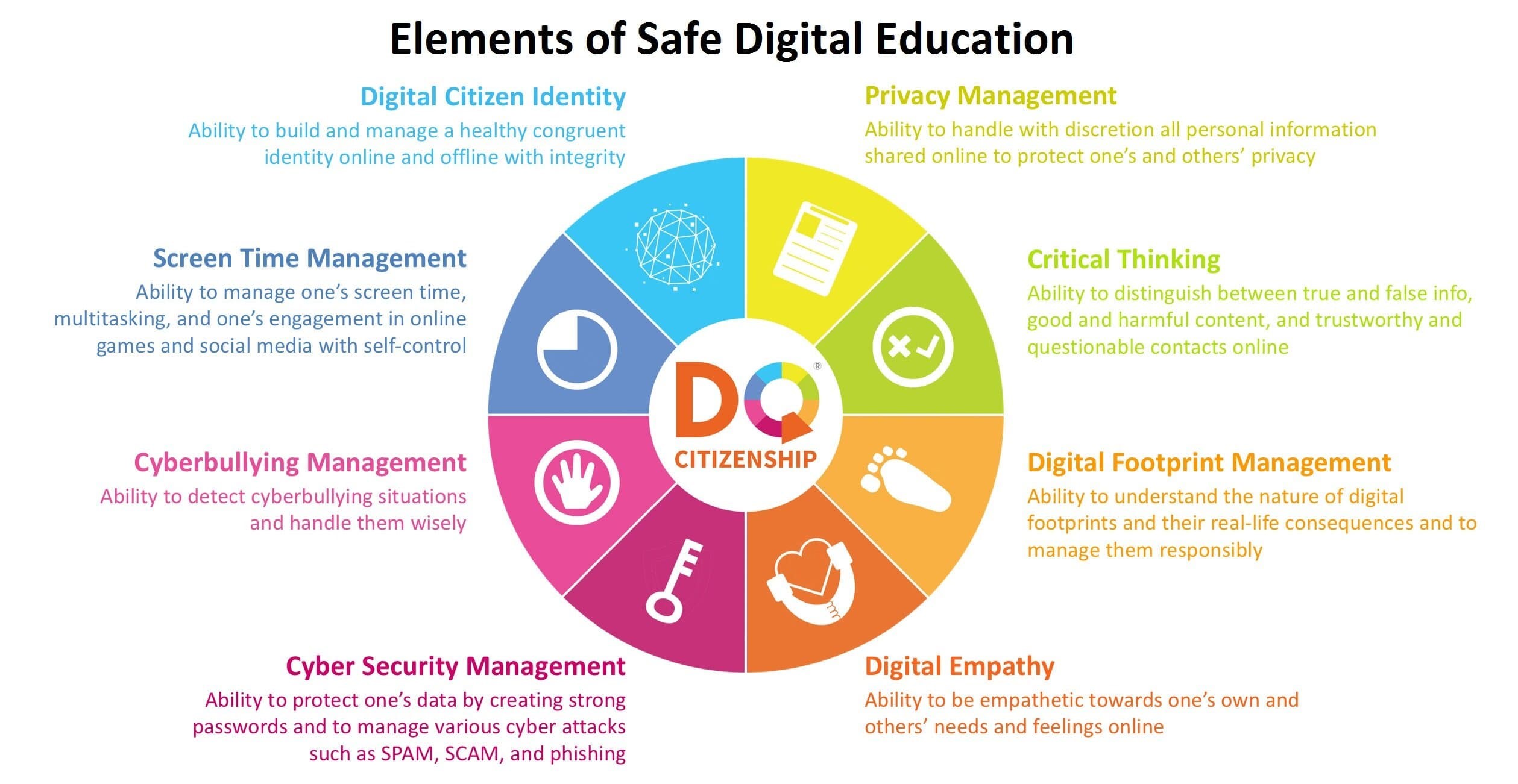
Facets of Digital Education: Digital education encompasses a broad spectrum of activities, including:
- Online learning platforms: Massive Open Online Courses (MOOCs), virtual classrooms, and learning management systems provide flexible and accessible learning opportunities.
- Digital content: E-books, interactive simulations, videos, and multimedia resources enrich the learning experience.
- Mobile learning: Mobile devices offer on-the-go access to educational content and apps.
- Artificial intelligence (AI): AI-powered tools can personalize learning, provide intelligent tutoring, and automate administrative tasks.
Transforming Learning Experiences: Digital education has the potential to revolutionize the way students learn and teachers teach. Some key benefits include:
- Personalized learning: Technology can adapt to individual learning styles and paces, enabling students to learn at their own rhythm.
- Accessibility: Digital education can break down geographical barriers and provide education to underserved populations.
- Enhanced engagement: Interactive content, gamification, and virtual reality can make learning more engaging and enjoyable.
- Lifelong learning: Digital platforms facilitate continuous learning and skill development throughout one’s life.
Open Standards for Education: India has made significant strides in promoting open standards for digital education, recognizing the importance of affordability, interoperability, and accessibility to ensure widespread access to educational resources. Key initiatives include:
- National Repository of Open Educational Resources (NROER): A platform by the Ministry of Education that provides a centralized repository of open educational materials, fostering collaboration among educators.
- National Digital Library of India (NDLI): Offers free access to a vast collection of academic resources, following open standards to ensure accessibility across various devices and platforms.
- SWAYAM: An online platform hosting Massive Open Online Courses (MOOCs) and other digital resources, ensuring compatibility with diverse learning management systems.
- DIKSHA: Developed by NCERT, DIKSHA provides a comprehensive hub of educational resources for teachers, students, and parents.
- National Digital Education Architecture (NDEAR): Aims to create a unified digital ecosystem for education, focusing on interoperability, data-driven decision-making, personalized learning, and inclusivity. It envisions a scalable, interoperable infrastructure to support diverse educational processes and enhance accessibility across India. It provides:
- Standards & Specifications: Ensuring interoperability across systems.
- Microservices & APIs: Unbundled services via APIs for diverse solutions.
- Reference Solutions: Ready-to-use apps and solutions.
- It serves five personas (Student, Parent, Teacher, Administrator, Community) and three ecosystems (Programs, Assets, Solutions) across learning and administration.
- These initiatives collectively represent a transformative approach to integrating technology into India’s education system, enhancing quality, accessibility, and equity across the nation.
Chapter 2- E-learning Barriers In Rural India
eLearning is an online education method that encompasses training and knowledge sharing conducted via the Internet.
- It is applicable in different contexts, including academic education, corporate training, continuous professional development, and skill enhancement courses.
- The promise of e-learning in bridging the digital divide and enhancing educational access in India is immense. However, the rural landscape presents a myriad of challenges that hinder its effective implementation.

- Digital Divide: Unequal distribution of digital infrastructure, with rural areas often lagging in internet connectivity, speed, and affordability.
- Power Supply: Erratic and unreliable electricity supply disrupts online learning sessions.
- Device Scarcity: Limited access to smartphones, computers, or tablets, especially among marginalized sections of society.
- Low Digital Literacy: A significant portion of the rural population lacks basic digital skills, hindering their ability to navigate online platforms and content.
- Economic Constraints: High costs of internet data and devices pose financial burdens on rural households.
- Language Barrier: Content primarily available in English or major Indian languages often excludes those who speak regional dialects.
- Lack of Quality Content: Limited availability of relevant and engaging educational content tailored to rural contexts.
- Teacher Training: Inadequate training of teachers in utilizing digital tools and platforms for effective instruction.
- Learning Environment: Distractions and unsupportive home environments can impede focused learning.
- Gender Bias: Persistent gender disparities in access to technology and education, affecting female students disproportionately.
- Socio-cultural Norms: Traditional mindsets and practices can hinder the adoption of e-learning, especially among marginalized communities.
- Digital Infrastructure: Inadequate internet connectivity, low bandwidth, and network instability disrupt online learning experiences.
- Device Compatibility: Issues with device compatibility, especially for older or low-cost devices, can hinder access to educational content.
- Digital Content Accessibility: Lack of accessible formats for students with disabilities, such as visually impaired or hearing impaired, limits inclusive learning.
- Cybersecurity: Vulnerabilities to cyber threats can compromise data privacy and disrupt online learning.
- Teacher Training: Insufficient training for teachers in using digital tools, developing online content, and facilitating virtual classrooms.
- Curriculum Adaptation: The need to adapt curriculum and teaching methodologies to suit the online learning environment.
- Assessment Challenges: Developing effective online assessment methods to measure student learning outcomes.
- Technical Support: Limited availability of technical support for students and teachers facing technical difficulties.
Strategies to Address e-Learning Challenges: To address e-learning challenges in rural India, effective strategies include:
- Bridging the Digital Gap: Providing affordable devices and internet access to ensure all students are connected.
- Personalized Learning: Implementing AI-driven platforms tailored to individual learning needs and paces.
- Empowering Students: Encouraging student participation through choices in learning content and interactive methods.
- Supporting Teachers: Enhancing teacher training in digital tools and fostering peer collaboration for effective online teaching.
- Public-Private Partnerships (PPPs): Collaborating with private entities to provide financial, technological, and human resources for rural e-learning.
- Community Learning Centres: Establishing local centers equipped with technology and internet to support students outside school hours.
- Cultural Learning: Ensuring online content is culturally relevant by incorporating local languages and community knowledge.
- Inclusion: Making e-learning accessible to students with disabilities by ensuring digital platforms are universally usable.
- Using Data for Improvement: Monitoring e-learning outcomes to continuously enhance effectiveness based on usage and feedback.
Chapter 3- AI Transforming The Learning Landscape In India
India, with its rapidly growing youth population, is on the brink of a digital transformation. At the center of this shift is Artificial Intelligence (AI), a technology that is not only revolutionizing industries but also reshaping the educational landscape.
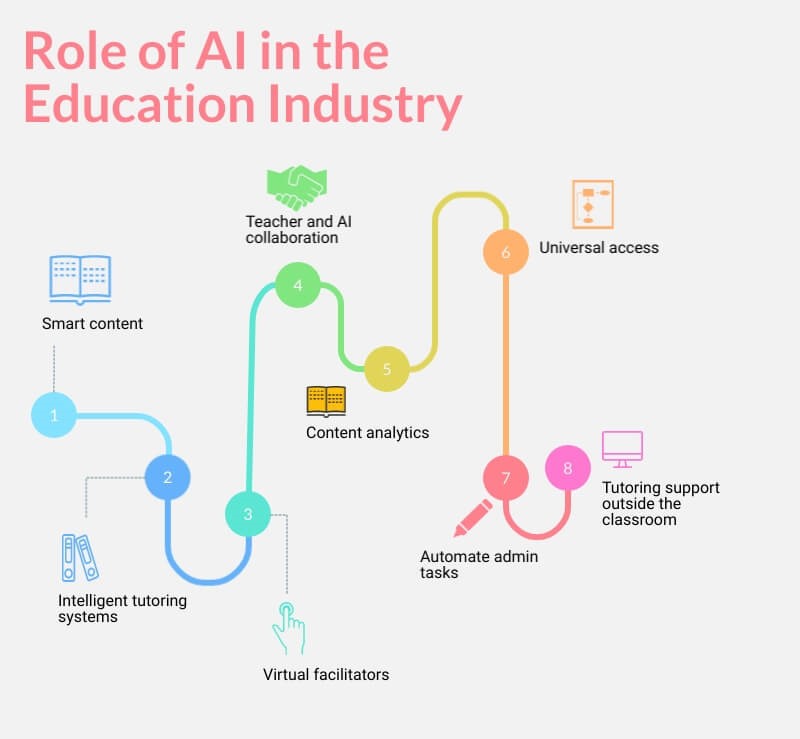
- India’s journey in e-learning began with basic online courses and digital content, but the landscape has evolved dramatically. With the growing accessibility of the internet and the affordability of smartphones, e-learning has become more widespread.
- This expansion has paved the way for AI integration, enabling more personalized and effective learning experiences.
- Large Language Models (LLMs) are at the cutting edge of AI’s influence on education.
- These models can understand and generate human-like text, making them ideal for developing intelligent tutoring systems, creating educational content, and personalizing learning platforms.
- India has seen significant progress in LLM research, driven by startups and academic institutions alike.
- The Indian government has recognized AI’s potential in education.
- Initiatives like the Digital India program and the National Education Policy (NEP) 2020 emphasize leveraging technology to enhance learning outcomes.
- India is harnessing Artificial Intelligence (AI) to tackle challenges in accessibility, education, and resource management.
- The government launched the National AI Program and the INDIAai portal to guide AI research and development.
- In December 2023, the first India-AI report highlighted AI’s potential to add USD 450-500 billion to India’s GDP by 2025 and USD 967 billion by 2035.
- Key initiatives include “Bhashini,” an AI-driven project breaking language barriers by translating regional languages, especially for rural areas.
- Additionally, the Atal Innovation Mission (AIM) has introduced over 1.1 million students to AI and advanced technologies through its Atal Tinkering Labs and collaborative programs like the “India AI Impact Festival.”.
- AI is becoming integral across various sectors, including education. As AI transforms industries, it’s crucial for educators and policymakers to ensure its responsible use.
- Responsible AI in education means creating fair, transparent systems that prioritize student welfare and ensure data privacy.
- Regular government oversight is essential to maintain ethical standards. Educators and policymakers in India need to monitor global AI developments and create policies that align with national needs and values.
Conclusion: AI is transforming e-learning in India by making education more personalized and accessible. It supports students with disabilities and language barriers, and fosters global collaboration.
- Initiatives like the India AI Mission and investments from tech companies are bridging educational gaps and enhancing access to quality education. Despite challenges, AI’s future in education looks promising, with great potential for innovation.
Chapter 4- E-gramswaraj
The 73rd Constitutional Amendment Act, 1992, marked a significant step towards decentralization of power by establishing Panchayati Raj Institutions (PRIs) as the third tier of governance.
In line with the government’s digital India initiative, the e-Gram Swaraj platform has emerged as a potent tool to enhance the efficiency, transparency, and accountability of these grassroots institutions.- Panchayat Profiling: Comprehensive database of panchayat details, including demographics, geographical information, and elected representatives.
- Planning: Facilitates participatory planning through Gram Panchayat Development Plans (GPDPs), aligning with national and state priorities.
- Progress Monitoring: Real-time tracking of physical and financial progress of development works, using geo-tagging for accurate location-based data.
- Accounting: Enables work-based accounting, ensuring transparency in fund utilization and expenditure management.
- Asset Management: Maintains a digital inventory of panchayat assets, facilitating better asset utilization and maintenance.
- Mobile Application: User-friendly mobile app for field-level data entry and monitoring.
1. Local Bodies: Rural and urban local bodies use eGramSwaraj for tasks like formulating Gram Panchayat Development Plans (GPDP), monitoring works, managing vendors and employees, and financial management.
2. Line Departments: These departments oversee social welfare programs and schemes across 29 subjects and 18 ministries, using data for effective planning, monitoring, and financial management.
3. Citizens: It provides data to citizens, empowering them to stay informed and involved in local development and decision-making processes.
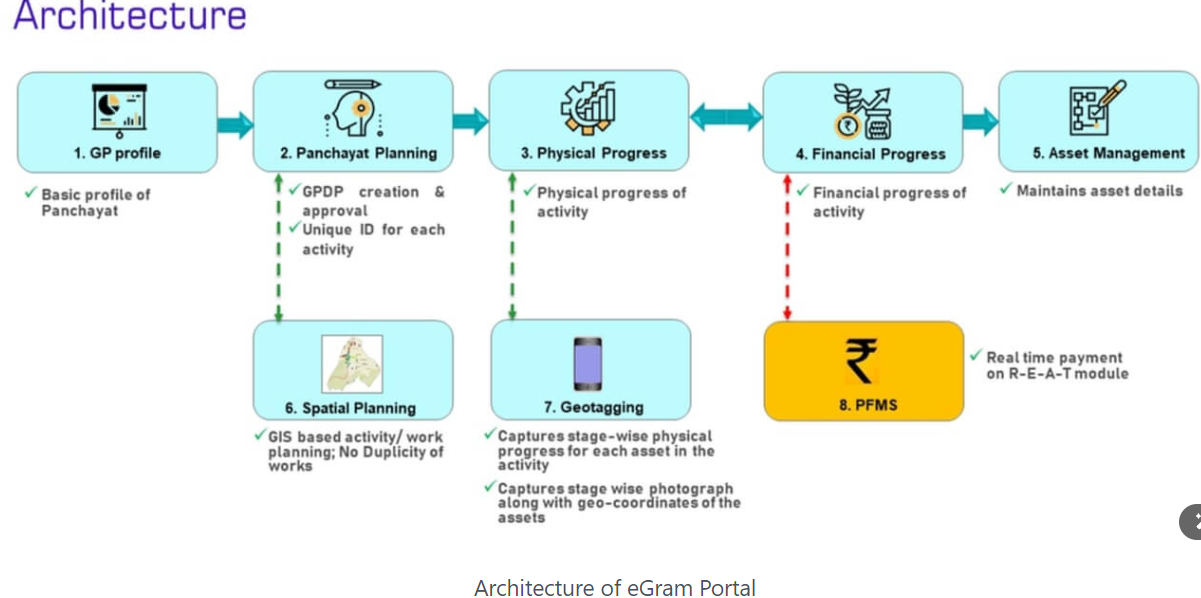
Modules of eGramSwaraj: It consists of 6 key modules:
1. Panchayat Profile: Provides general information about Gram Panchayat, including details of elected members, committee members, and employees, facilitating easy access for citizens and visitors.
2. Planning: Manages planning and approval of works based on Gram Sabha meetings. Includes the Spatial Planning Application, Gram Manchitra, which uses geographic data for facility planning and sustainable development.
3. Progress Reporting: Tracks the physical and financial progress of activities, reflecting technical and administrative approvals, and managing funds from various schemes.
4. Accounting: Implements the Model Accounting System (MAS) for budget and financial management, including voucher-based transactions, vendor and employee details, and reconciliation processes.
5. Asset Directory: Updates and manages the status of assets, including details on changes, reasons for status updates, and dates.
6. User Management: Manages user accounts, access levels, and credentials for system administrators.
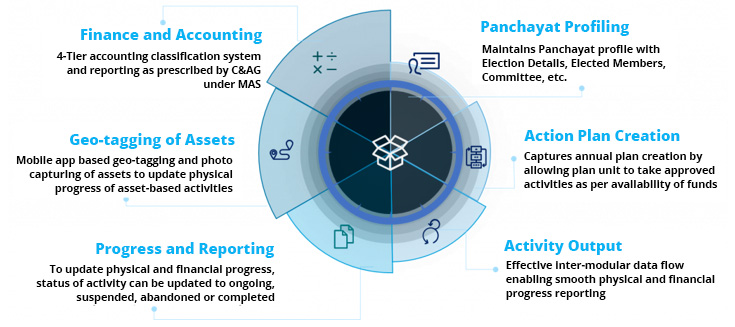
Challenges and Way Forward
Despite its potential, e-Gram Swaraj faces challenges such as digital literacy, infrastructure constraints, and data quality issues. To overcome these challenges, concerted efforts are required to improve digital literacy, strengthen infrastructure, and ensure data accuracy. Additionally, continuous capacity building of panchayat functionaries is essential for effective utilization of the platform.
Chapter 5- E-learning As A Catalyst For Health And Nutrition Awareness
In India, particularly in rural areas, disseminating health and nutrition information has been challenging. However, e-learning technologies offer a promising solution by providing scalable, interactive, and customizable platforms, such as online courses and mobile apps, to overcome geographical barriers and improve health and nutrition awareness effectively.
Government Schemes and Programs to promote e-learning and Improve Health and Nutrition Awareness in Rural Areas- The Digital India initiative: It launched in 2015, aims to create a digitally empowered society by enhancing internet access, digital literacy, and electronic government services. Key components include:
- Common Service Centres (CSCs): Digital hubs in rural areas for accessing e-learning and health information.
- e-Sanjeevani: Telemedicine service connecting rural patients with urban doctors.
- Digi locker: Platform for securely storing and sharing health and education documents.
- Pradhan Mantri Gramin Digital Saksharta Abhiyaan (PMGDISHA): Program to improve digital literacy in rural areas with health and nutrition modules.
- National Digital Literacy Mission (NDLM): Provides digital literacy, including health e-learning.
- e-Health: Offers online healthcare services like registrations and payments.
- E-education: Provides online education via smartphones and apps.
- eRaktKosh: Centralized blood bank management system.
- SeHAT: Tri-services teleconsultation for defense personnel and families.
- National Digital Health Mission (NDHM): It seeks to establish a robust digital health infrastructure in India, facilitating connectivity among various healthcare stakeholders via digital platforms.
- It aims to create an integrated online system that provides extensive data and services while ensuring the security and privacy of personal health information.
- Additionally, the Standardization Testing and Quality Certification (STQC) is tasked with assessing the compliance of all NDHM components, including systems, software applications, networks, and processes.
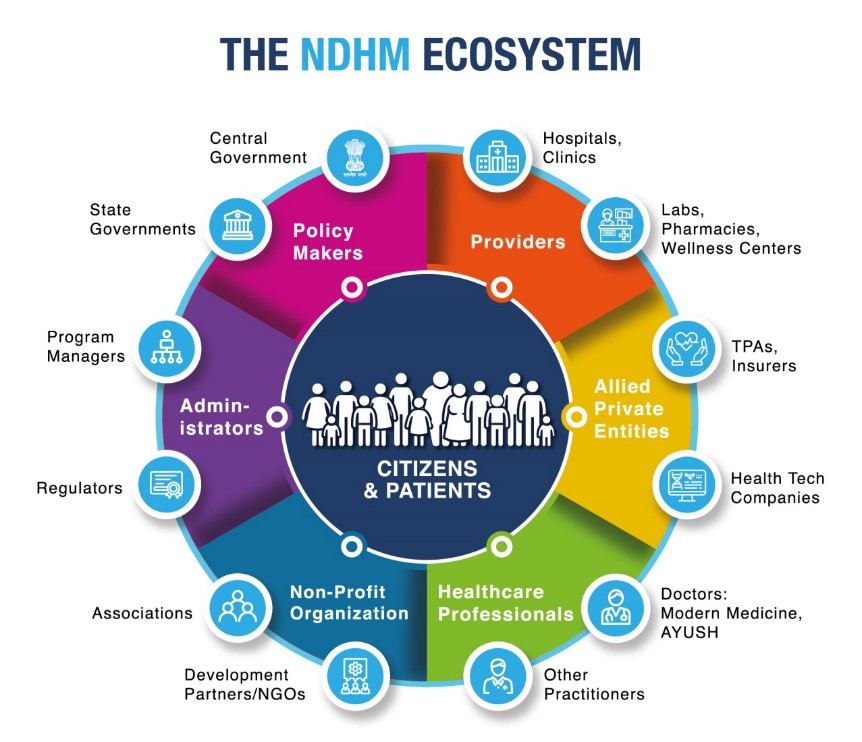
- Saksham Anganwadi and Poshan 2.0 Scheme: The Saksham Anganwadi and Poshan 2.0 scheme, implemented from 2021-22 to 2025-26, aims to enhance nutrition and child development through updated guidelines and improved ICT components. Key aspects include:
- Nutrition Support: Provides supplementary nutrition for children, pregnant women, lactating mothers, and adolescent girls in specific regions.
- Early Childhood Care: Focuses on early childhood education and stimulation.
- Anganwadi Infrastructure: Upgrades to modern Saksham Anganwadi centers.
- Poshan Abhiyaan, launched in 2018, aims to reduce malnutrition and anemia by leveraging technology and e-learning. It uses mobile apps, e-learning platforms, and social media for nutrition education. Key initiatives include:
- ICT-RTM (Information Technology-Real Time and Communication Monitoring): Monitors and evaluates nutrition status using mobile apps.
- Poshan Maah and Poshan Pakhwada: Uses e-learning for nutrition workshops and digital campaigns.
- Poshan Tracker: An ICT platform for real-time monitoring and management of supplementary nutrition services.
- The Ayushman Bharat Digital Mission (ABDM): It aims to create a foundational digital health infrastructure in India, facilitating better connectivity and integration among various stakeholders in the healthcare ecosystem through digital means. Key components include:
- Healthcare Professionals Registry (HPR): A database of all healthcare professionals.
- ABHA Mobile App (PHR): Personal Health Records managed by individuals.
- Health Facility Registry (HFR): A repository of all health facilities.
- Unified Health Interface (UHI): An open protocol for digital health services like appointment booking and teleconsultation.
- ABHA Number: A Unique Health ID for linking health records.
- Aarogya Setu: A National Health App for Digital Health ID and interactions with healthcare providers.
- e-Hospital: A cloud-based system for hospital management connecting patients, hospitals, and doctors.
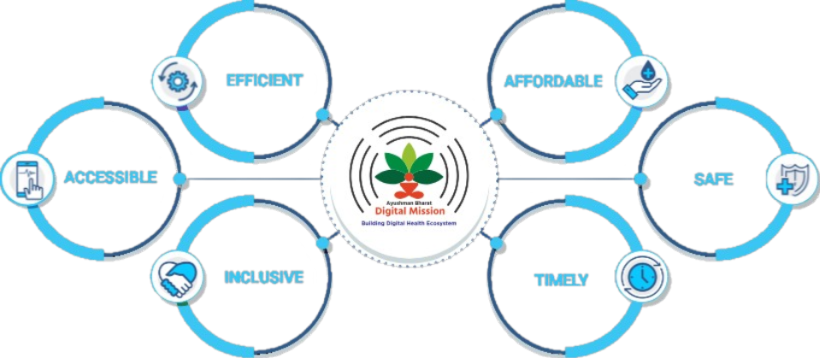
- Swasth Bharat Prerak (SBP) Programme: It was launched in January 2018 by the Ministry of Women & Child Development and Tata Trusts, supports the POSHAN Abhiyaan by providing administrative and managerial assistance to enhance health and nutrition outcomes.
- It leverages technology, including e-learning platforms, to train community health workers and disseminate information.
- The Swasth Bharat Yatra is a related nationwide campaign featuring digital workshops, webinars, and e-learning modules focused on health and nutrition awareness.
- e-School for Farmers: These are run by the Ministry of Agriculture and Farmers Welfare, offers online courses on agriculture, health, and nutrition. It includes video tutorials, interactive sessions, and expert advice to help farmers improve their knowledge and livelihoods.
- National Health Mission (NHM): It was launched in 2013, aims to deliver accessible and quality healthcare to rural areas, focusing on maternal and child health, nutrition, and disease prevention.
- It uses e-learning to train healthcare providers and the community.
- ASHA Training Modules enhance the knowledge of Accredited Social Health Activists (ASHAs) about health and nutrition, while the Janani Shishu Suraksha Karyakram (JSSK) uses digital platforms to educate mothers on prenatal and postnatal care, nutrition, and infant health.
- Rashtriya Bal Swasthya Karyakram (RBSK): It focuses on child health through regular check-ups and nutritional support. It uses e-learning to train health workers and educate parents.
- Mobile Health Teams and a Child Health Screening App also utilize e-learning to share health and nutrition information with caregivers and healthcare workers.
- PM e-VIDYA: It was launched on May 17, 2020, aims to unify digital education efforts in India. It includes:
- DIKSHA: A digital platform offering e-content and QR-coded textbooks for school education.
- Swayam Prabha TV Channels: One TV channel per class from 1 to 12.
- Radio and Podcasts: Use of radio, community radio, and CBSE’s Shiksha Vani.
- Accessible e-content: Special resources for visually and hearing-impaired students.
- MANODARPAN: A program providing psychosocial support for mental health and emotional well-being.

- PM Poshan Scheme: It was formerly the Mid-Day Meal Scheme, provides hot meals to students in government and aided schools from 2021-22 to 2025-26.
- It integrates e-learning to enhance health and nutrition awareness through:
- Nutrition Education in Curriculum: Digital modules teach students about balanced diets and hygiene.
- Interactive Content: Videos, animations, and quizzes make learning engaging.
- Teacher Training: Online programs train educators on integrating nutrition education.
- Digital Resources: E-books and digital resources support educators.
- Virtual Workshops: Webinars for parents and community members on child nutrition.
- Digital Campaigns: Social media and digital platforms spread awareness.
- Digital Monitoring: Tools track the program’s implementation and impact.
- Feedback Mechanisms: E-platforms collect feedback for program improvement.
- Collaboration and Partnerships: Works with initiatives like ABDM and partners with NGOs and the private sector to enhance digital content and reach.
- Mobile Health (mHealth) Initiatives: It leverage mobile technology to enhance healthcare delivery and information access in rural India. Key elements include:
- National Health Helpline: 24x7 toll-free helpline provides accessible health information.
- SMS Campaigns: Regular updates with health tips and nutritional advice.
- Voice Messaging Services: Automated messages for low literacy users.
- Mobile Academy: Free audio training for ASHAs, available anytime via mobile.
- mbDiabetes Program: Real-time SMS alerts for diabetes management.
- Kilkari: IVR service delivering weekly audio messages on pregnancy and childcare.
- mSakhi: App for health workers with maternal and child health information.
- eSanjeevani: Telemedicine service for remote consultations.
- Poshan Atlas: App providing interactive nutritional advice and diet plans.
- Poshan Abhiyaan: Mobile tech for multimedia content on nutrition.
- Monitoring Tools: Apps like mHealthaTB and ANMOL track health data and treatment adherence.
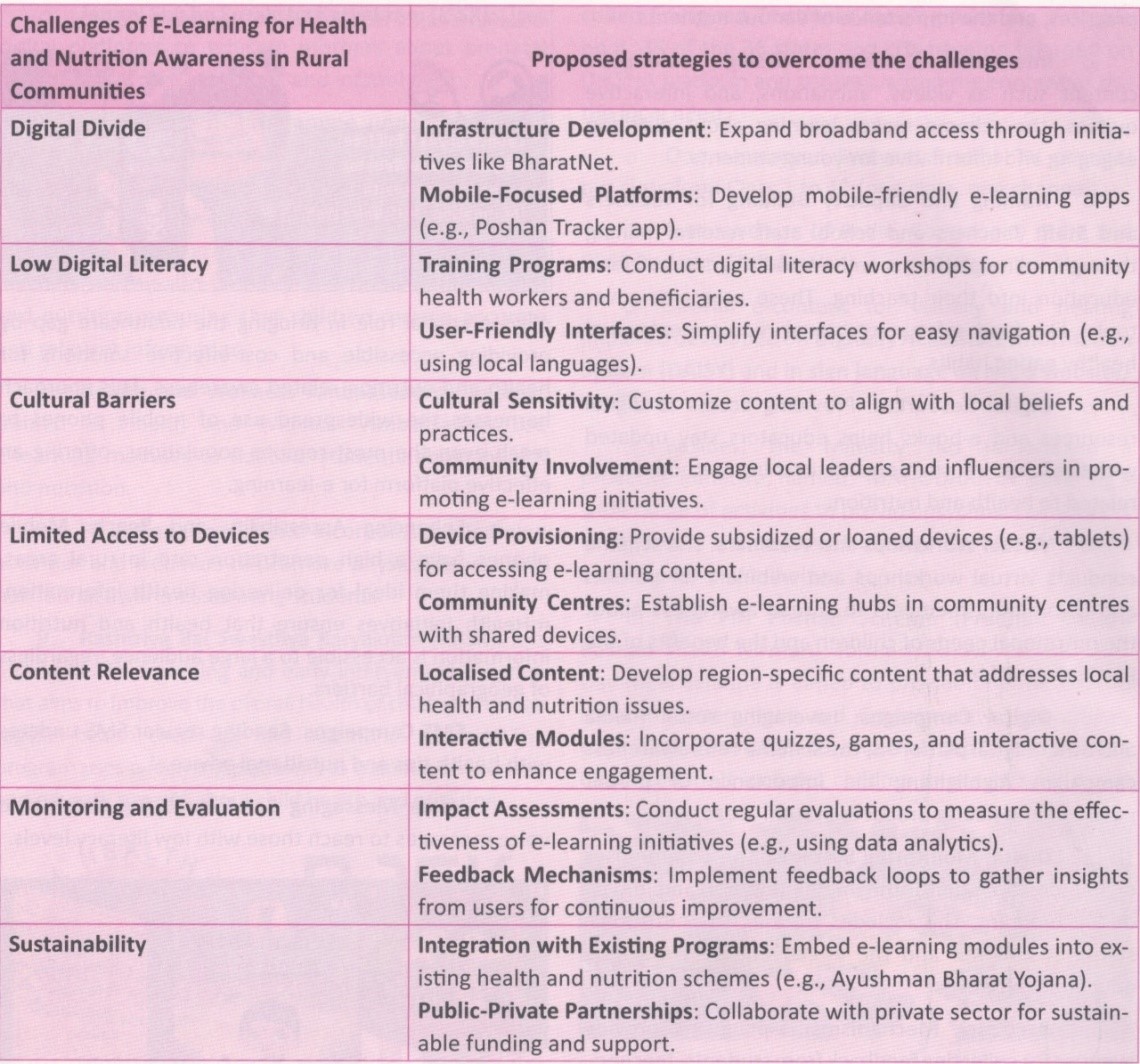
UPSC Mains Practice Questions-(Around 250 Words)
Q.1 Discuss the benefits and challenges of e-learning in rural India. What strategies can improve access and quality of e-learning in these areas?
Q.2 Assess the impact of e-learning on health and nutrition awareness in rural communities. How can digital platforms address barriers and improve health outcomes?